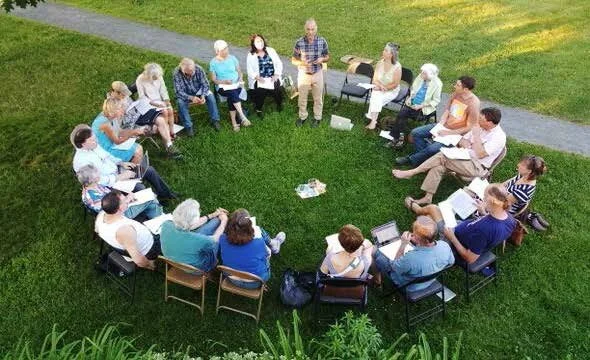Weed warriors uproot invasive species, Wheeler Nature Park sees some TLC
Mike Bald girdles a common buckthorn, completely removing a layer of bark in a circular pattern to stop the spread of buckthorn without potentially causing harm to other trees. Buckthorns look similar to other fruit trees like apple or cherry but produce a small berry and have a unique orange layer under their bark. Buckthorns were introduced in the 1800s and are thick-growing and fast-spreading, “shading out” other types of trees.
Photo by Claire MacQueen | Community News Service
Unfledged weed warriors armed with gloves and garden shears gathered at the entrance to Wheeler Nature Park on June 19, ready to learn about and assist with the removal of invasive plant species in South Burlington.
The Weed Warriors program began in 2017 to address invasive species in City Center Park, led by Mike Bald, owner of Got Weeds?
According to Ashley Parker, South Burlington’s city project manager, the goal of the program is to train volunteers who will then return to natural areas and deal with invasive species on their own. It has since expanded to include Red Rocks Park, Wheeler Nature Park and Underwood Property.
“The ultimate goal is diversity and resilience … a place that can function, really, without too much heavy-handedness on our part,” said Bald.
Bald, who has worked to protect natural areas from harmful invasive species since 2003, uses only manual methods, advocating against the use of herbicides in his work.
At the park on June 19, he gestured to a row of tall grasses that border the parking lot around Wheeler Nature Park. Though similar in height, there were two distinct species: the invasive phragmites and native cattails.
Bald spoke about how the cattails were being crowded out as the invasive species outcompeted them, “gently, year after year, a few feet at a time.”
Disposing of weeds in the right way is another aspect of managing invasive species within natural spaces. Pinched between two leaves, Bald held the pale root of a wild parsnip he’d found.
Though it varies by species, drying out a plant by hanging it from a tree or elevated surface is one way to keep smaller species from reemerging.
“You can’t be sloppy with vegetation in the first part of the year — May and June — because if I throw that on the ground, it could actually recover,” said Bald.
It was not a planned discovery, but the root led into the conversation of safety while dealing with invasive species: when in contact with the sun, wild parsnip root can cause a chemical burn on human skin.
Long pants, sleeves and gloves help protect against the oils of some plants, as well as sun damage and bug bites. Consistent hydration is also important when out weeding during the summer, whether in a natural area or one’s own garden.
Education is vital as well: Bald recommends not going after plants like the wild parsnip or similarly dangerous plants such as wild chervil, giant hogweed and poison ivy. Instead, contact a professional.
The next weed warriors event is June 26 at 9 a.m. and will take place in Red Rocks park. For more information or to register, contact Ashley Parker at: aparker@sburl.com.
To view published article, click here.







